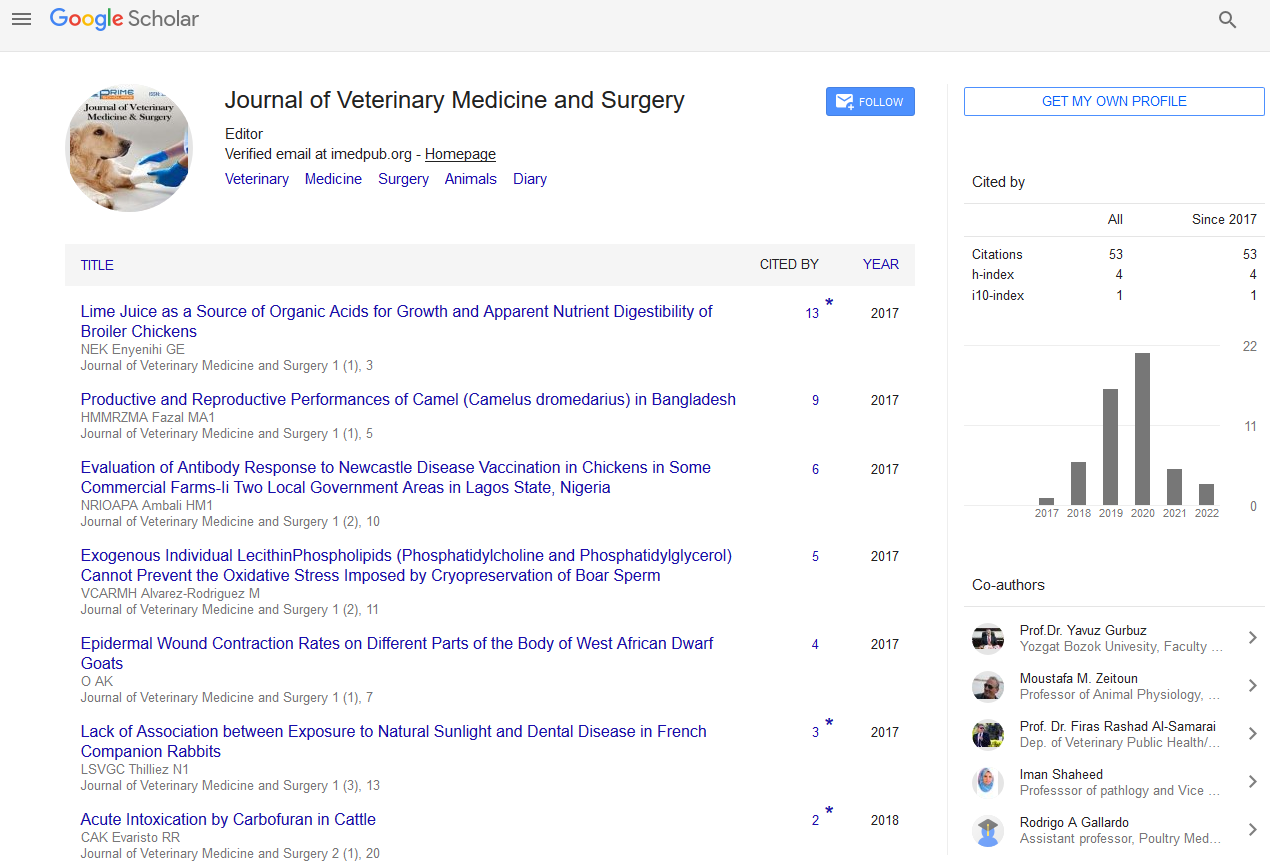Commentary - (2024) Volume 8, Issue 4
Veterinary Microbiology: Understanding the Role of Microorganisms in Animal Health
Joseph Clark*
Department of Microbiology, Georgetown University, USA
*Correspondence:
Joseph Clark,
Department of Microbiology, Georgetown University,
USA,
Email:
Received: 02-Dec-2024, Manuscript No. IPJVMS-24-22174;
Editor assigned: 04-Dec-2024, Pre QC No. IPJVMS-24-22174 (PQ);
Reviewed: 18-Dec-2024, QC No. IPJVMS-24-22174;
Revised: 23-Dec-2024, Manuscript No. IPJVMS-24-22174 (R);
Published:
30-Dec-2024, DOI: 10.36648/2574-2868.8.4.37
Description
Veterinary microbiology is a specialized branch of veterinary
medicine that focuses on the study of microorganisms
such as bacteria, viruses, fungi, and parasites that affect
animals. This field is critical for understanding the causes
of infectious diseases in animals, as well as developing
strategies for diagnosis, treatment, and prevention. Veterinary
microbiologists work to ensure that animals remain healthy and
that zoonotic diseases, those that can be transmitted between
animals and humans, are effectively controlled. Veterinary
microbiology plays a vital role in safeguarding animal and
human health. By identifying the microorganisms responsible
for animal diseases, microbiologists can develop diagnostic
tests, vaccines, and antibiotics to treat infections. This field is
particularly important in controlling the spread of infectious
diseases that can devastate livestock populations, threaten
wildlife, or cause public health concerns due to zoonotic
transmission. Microorganisms, including bacteria, viruses,
fungi, and parasites, can cause a wide variety of diseases in
animals. These diseases may range from mild infections to lifethreatening
conditions, and can spread rapidly, particularly in
crowded environments such as farms, shelters, or veterinary
clinics. Effective control and prevention of these diseases rely
on a thorough understanding of microbiological principles and
the ways in which these pathogens interact with their hosts.
Accurate diagnosis is crucial for effective treatment and control
of infectious diseases in animals. Veterinary microbiologists
use a variety of diagnostic techniques to identify pathogens,
including: One of the most significant aspects of veterinary
microbiology is its role in controlling zoonotic diseases that
can be transmitted from animals to humans. Zoonoses, such
as rabies, leptospirosis, and salmonellosis, pose a significant
public health risk. Veterinary microbiologists play a crucial
role in identifying and controlling these diseases in animals,
reducing the likelihood of human transmission. Preventing
zoonotic outbreaks requires a multidisciplinary approach,
involving veterinary professionals, public health experts, and
environmental scientists. Effective surveillance, vaccination,
and hygiene practices in both animal and human populations
are essential in minimizing the risk of zoonotic diseases. In
recent years, veterinary microbiology has seen significant
advancements, particularly in the areas of molecular
diagnostics, vaccine development, and antimicrobial resistance
research. New technologies, such as next-generation
sequencing (NGS), allow for more precise identification of
pathogens and their genetic makeup. This has improved our
ability to track disease outbreaks and understand the evolution
of pathogens, especially in the context of antimicrobial
resistance. Additionally, research into the microbiome the
community of microorganisms living in and on animals has
opened new avenues for understanding how these microbes
affect animal health. The microbiome plays a crucial role
in digestion, immunity, and disease resistance, and better
understanding it may lead to novel therapies and preventative
measures. Veterinary microbiology is a cornerstone of animal
health, enabling veterinarians and researchers to diagnose,
treat, and prevent infections in animals. From bacterial and
viral infections to parasitic and fungal diseases, veterinary
microbiologists play a key role in understanding how
microorganisms interact with animals and how to control
their spread. As research in this field continues to evolve, new
diagnostic techniques, treatments, and prevention strategies
will further enhance the ability to protect animal health and
prevent zoonotic diseases from impacting human populations.
Acknowledgement
None.
Conflict Of Interest
None.
Citation: Clark J (2024) Veterinary Microbiology: Understanding the Role of Microorganisms in Animal Health. J Veterinary Med.
8:37.
Copyright: © 2024 Clark J. This is an open-access article distributed under the terms of the Creative Commons Attribution Li-
cense, which permits unrestricted use, distribution and reproduction in any medium, provided the original author and source
are credited.

